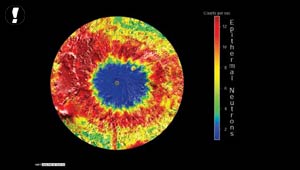"2001 Mars Odyssey" located large amounts of hydrogen at the planet's south pole; Water is considered an essential element for the development of life; The last two spacecraft that tried to reach the planet failed in the mission
3.3.2002
The south pole of Mars in a photograph from the spacecraft. 30x sharper photos (NASA)

Yesterday, NASA published the first images and data collected by the "Mars Odyssey 2001" spacecraft, which include evidence of significant amounts of frozen water on the surface of the planet, or slightly below it.
The findings are based on preliminary measurements that located large amounts of hydrogen close to the surface, in the south pole region of Mars. "The most likely possibility is that the high hydrogen content indicates the existence of ice water in the South Pole region," said a message published by NASA. However, the announcement also stated that further analysis of the data is needed to "check what quantities are involved and confirm the interpretation that it is frozen water".
Advertising
The scientists said that the amount of water ice in the north pole of Mars cannot be estimated, because winter is just ending there, and the area is overshadowed by frozen layers of carbon dioxide, which make it difficult to photograph and collect data.
In recent years, photographs were sent from Mars that strengthened the hypothesis that the planet was not always arid and cold as it is today, and perhaps in the past water flowed through it. Large reservoirs of frozen water may have been preserved in the ice caps at the poles and other regions. Water is considered an essential element for the development of life, therefore one of the main tasks of the "Odyssey" is to collect new clues about the possibility that in the past there was - and maybe still is - water on the planet.
The spacecraft, which cost $300 million to build, is not just looking for water reservoirs. It has two other important tasks: to map the mineral composition of the surface, and to collect data about the radiation in space close to Mars. NASA says that the information about the radiation is essential for assessing the health hazards that will be faced by astronauts from Earth who may be sent to the neighboring planet in the future.
"The results exceed our expectations"
The fact that the spacecraft even reached Mars, and that it is sending data, is in itself a great success for NASA. More spacecraft have been sent to Mars than any other object in our solar system, with the exception of the Moon. The first attempt to launch a spacecraft to Mars was made by the Soviet Union in 1960. Since then, another 30 attempts have been made, but only less than a third of them have been crowned with success. The mission of the last two spacecraft that NASA tried to launch ended in embarrassing failure.
In 1999, the "Mars Climate Orbiter" was supposed to orbit Mars, but it crashed in the atmosphere due to poor planning. In the same year, contact with the "Mars Polar Lander" was lost due to a navigation error, the cause of which has not been fully deciphered.
The failures forced NASA to postpone to 2003 the launch of a spacecraft that was supposed to be sent to Mars this year. "We have a spacecraft that is performing very well, and the results are exceeding our expectations," said Roger Gibbs, deputy director of the Odyssey project. According to him, the sharpness of the photographs that came from a camera that captures infrared rays, is thirty times higher than any other photograph that has come from Mars so far.
"We are happy with the quality of the data received," said Dr. Steve Saunders, Odyssey's chief scientist. "Now we can actually see water, instead of guessing where it is or where it was."
